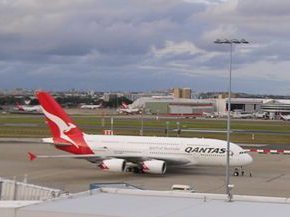The announcement last September that Australia’s national airline Qantas would establish a decade-long alliance with Emirates represents a boon for travellers to the island nation. The alliance, due to begin in April, sees Qantas and Emirates frequent flyer points being shared between two programs, Emirates codesharing on Qantas flights across Australia, Qantas codesharing on Europe bound flights, and shared facilities which are the standard for such alliances.
The announcement also makes sense for Qantas, which has seen a decline in profits on international sectors in recent years. The Australian icon was freed from government regulation in the early 1990s and soon privatised. The result has been a mix of competitive market moves, like the establishment of Jetstar in 2003, and a dwindling set destinations list – Qantas hasn’t flown to Paris or Rome since the turn of the millennium, southern Europe destinations like Athens are ancient history, and in 2012 the flying kangaroo ended its operations to the subcontinent by halting services to Mumbai. Even destinations which seemed logical such as Beijing and San Francisco have been given the flick, forming part of a worldwide withdrawal from lesser profitable (or outright unprofitable) routes.
The Emirates tie-up allows Qantas to sell tickets to a whole bunch of destinations which it could never justify servicing alone. Paris, Rome, Athens are a few of a whole host of European destinations which Qantas will now be able to easily sell tickets to. Following Qantas’ withdrawal from these routes in the past two decades, Qantas offered fares through their alliance with British Airways. This substandard solution forced passengers loyal to Qantas to stop twice before reaching their destination – once to refuel in Asia somewhere (Singapore, Bangkok or Hong Kong), and then again to change planes at the quagmire that is London Heathrow. Not to mention the feeling of helplessness felt by passengers bound for eastern Europe who were forced to fly past their destination, only to board a British Airways flight and backtrack their way across the channel and the continent. This inadequacy of this situation was highlighted when one attempted to book a flight to Dubai through the Qantas website just a couple of years ago; the Qantas/BA solution was to fly all the way to London, and then one third of the way back with the British carrier.
The Emirates tie-up also opens up a whole raft of options to Qantas, which may one day be allowed to base aircraft in Dubai. Being that much closer to Europe than its Asian hubs, Qantas could operate smaller aircraft from Dubai to key destinations such as Frankfurt or London as passenger load necessitates. On quiet days under the previous scenario, a smaller aircraft would not be able to operate from Singapore to London non-stop, forcing the airline to fly a half-full (and therefore loss-making) 747 or A380 for 14 hours. Wherever passenger demand is lower, Qatar Airways operates A320 aircraft on the seven-hour hops between their Doha base and Europe – Qantas does the same thing on lower-yield operations to New Zealand, such as Wellington and Queenstown. Although the details of this are not yet confirmed (and unlikely in the short-term), the Emirates deal opens the door to a potential whole new era of Europe operations for the flying kangaroo.
If Qantas does not operate additional flights into and out of Europe, the spare aircraft could be used on increasingly competitive and lucrative Asian flights. Qantas could open up services to a plethora of ports in China, such as Beijing, Chengdu, Kunming or Guangzhou, where business passengers are willing to pay for quality direct services. Seoul is another example of a destination with potential for premium bookings, especially since Korean Airlines terminated their Melbourne service this month. Even the subcontinent could be on the cards again if one considers the potential for codesharing. Emirates and Qantas both fly to Singapore, from which Qantas’ low cost subsidiary Jetstar operates a base. Another Jetstar operation is in the formative stages in Hong Kong, another Qantas and Emirates junction. Jetstar aircraft could meet Qantas flights arriving in Singapore, feeding passengers onwards to low yield destinations like Chennai, Bengaluru, Hyderabad and Colombo. Similar operations could feed through Hong Kong to the north and east – Kathmandu, Kolkata and Dhaka. On the other hand, Qantas’ mainline operations would provide premium services to Delhi and Mumbai, with the option to revert these to Jetstar (or even Emirates via Dubai) if they prove unprofitable. Emirates also provides excellent connections to Pakistan, a nation notoriously difficult to reach from Australia due to a lack of willing airlines.
Finally, the Qantas – Emirates deal has the potential to return to Qantas the lustre is has lost in recent years. Qantas’ flights to South and North America could form part of a round-the-world ticket offered in conjunction with the Dubai-based carrier; Los Angeles, Dallas and New York are destinations common to both airlines. Qantas could offer tickets across the Pacific for Emirates, something the Arab airline has been barred from doing thanks to regulations. Emirates does not belong to any global network, and is famously non-committal with airline tie-ups, so here stands the chance for the two to form their own exclusive, luxurious, high-end alliance, targeting the natural and historic demographic for both carriers. The excellent Emirates hub in Dubai is designed exclusively for A380 aircraft and their passengers – now Qantas passengers will deplane there before jetting off to their European destination. At the very least, Qantas passengers won’t be bumped off on to Bloody Awful (BA) and treated to standing in line at an unfriendly Heathrow just to head backwards towards the Mediterranean. At this stage, it seems that the sky really is the limit.








Very good information. Lucky me I came across your blog by accident (stumbleupon).
I have bookmarked it for later!
Thank you! I’m glad you liked it! At the moment Qantas doesn’t fly to Vietnam in its own right (only through Jetstar), but Ho Chi Minh City or Hanoi are perfect candidates for a reorganised Qantas route network.
Why viewers still use to read news papers when in this technological
world all is accessible on web?
Thanks for reading!! It sure beats me!!